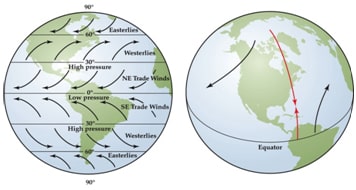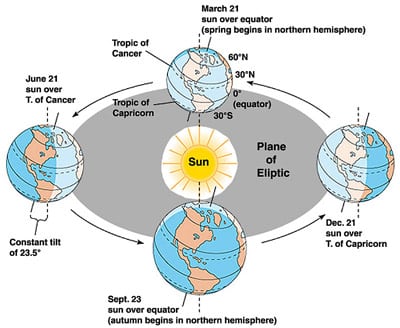Another type of motion is known as revolution. Revolution is when one object completes a circular path around another object. The Earth takes 365.24 days to revolve around the Sun. This is why a year is 365 days long. During the year the Earth is angled differently towards the Sun. These changing angles provide us with different Sun intensities and therefore we get four different seasons. Since the Earth is at different positions in space over the year, we see different constellations throughout the year.
Coriolis Effect:Defection of wind due to rotation of Earth
UP [NORTH]:WestDOWN [SOUTH]:East (On Surface)
Northern Hemisphere:Deflected to the right (clockwise)
Southern Hemisphere:Deflected to the left (counter-clockwise)
Trade Winds:high pressure wind blown to the west from 30N
Westerlies:deflected to the east
Earth is currently in a cool phase characterized by formation of glaciers (glacial maxima), followed by warm periods with glacial melting (interglacialperiods). These glacialinterglacial cycles occur at frequencies of about 100,000 years. We are currently in an interglacial period; these have lasted about 23,000 years in the past. The last glacial maximum was about 18,000 years ago.
The glacialinterglacial cycles have been explained by regular changes in the shape of Earths orbit and the tilt of its axis—Milankovitch cycles.
Circular rotation causes glaciers to melt; more solar radiation; Elliptical= less radiation. The intensity of solar radiation reaching Earth changes, resulting in climatic change. The shape of Earths orbit changes in 100,000-year cycles. The angle of axis tilt changes in cycles of about 41,000 years. Earths orientation relative to other celestial objects changes in cycles of about 22,000 years.





